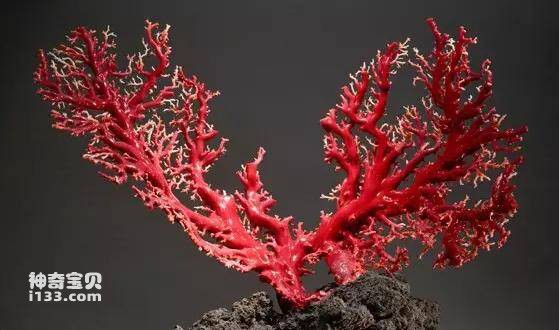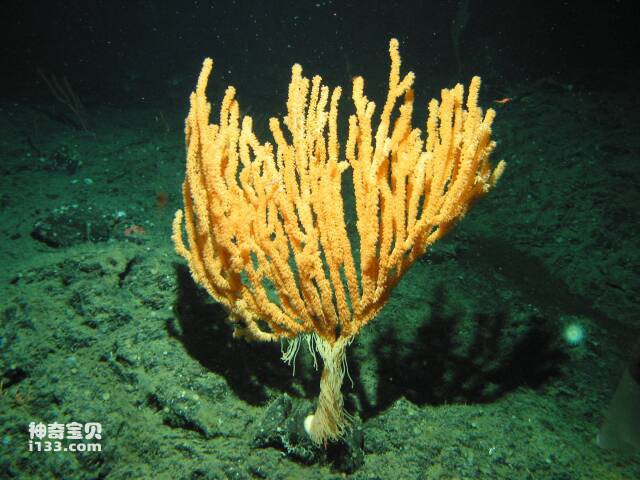1. Red coral
In the past, red coral was given as tribute to the emperor, used as medicine for treating diseases, red coral was the prayer beads that Buddhists worshiped, and red coral was worn by the second-grade civil servants and generals of the Qing Dynasty. In short, people think that red coral is a treasure. What exactly is red coral? What are its properties? People know very little about it. It has been rumored for a long time, and coupled with the mysterious rendering, it makes people even more confused.
Red corals are marine lower invertebrates, belonging to the phylum Coelenterata, the class Anthozoa, the subclass Octocora, the order Soft Corals, the suborder Scleroderma, the family Rhodoporaceae, and the genus Rhodopora. The red coral that people see is the remaining skeleton.

(1) Biological characteristics of red coral
The habitat conditions required for the growth of red corals are known from surveys in the Mediterranean-Atlantic and Pacific areas. They require hard bottom, fast currents, no sediment (especially no terrestrial sediment), clear water, low light, Low temperature (8~20℃), among which the optimal temperature of the Mediterranean red coral field is 10℃.
(2) Slow growth and long life
Red corals do not become sexually mature until 10 to 12 years after their larvae attach. They lay eggs every summer, and their floating larvae are negatively phototaxis. Since red corals live longer than other invertebrates, their slow growth rate and low adult mortality are inevitable trends.

2. Bamboo coral
Bamboo coral is formed due to the petrification of its axis and the separation of light brown nodes and white internodes. It is quite similar to the natural bonsai dianthus. It is particularly poetic when displayed in the living room. It has been widely used among Chinese people.
3. The formation of coral reefs
Coral reefs or coral islands are formed by the accumulation of the remains of coral polyps over geological time.
We refer to the corals that form coral reefs as reef-building corals. Most reef-building corals live in colonies, and each individual in the colony is very small, generally 1 to 3 mm in diameter. The structure of a single individual is similar to that of a sea anemone. Their skeletal components are all calcium carbonate. Calcium is secreted from the epidermal cells at the base of the individual's base and the lower end of the body column, which together form a cup-shaped skeleton. When the cup-shaped skeleton is formed, the base of the individual's base secretes calcium to form the base plate and body column. The calcium secreted from the lower end forms the surroundings of the cup. The corals in the group are connected to the bottom of the coral cup. The cup walls are shared and they reproduce and grow upward through budding. Generally, under the same conditions, block corals only grow by 0.5 to 2% per year. Millimeters thick, branched corals can grow 10 to 20 centimeters. In this way, countless small coral polyps continue to grow and reproduce. After many years, they grow into the patches and bunches of coral we see. Together with the corpses of other animals and plants that form calcium skeletons, such as molluscs, brachiopods, echinoderms, calcareous algae, etc., they can form reefs and islands in the ocean through the accumulation of geological time.

Not all sea areas can form coral islands. The growth and development of corals require strict ecological conditions.
First of all, temperature is the limiting factor that affects the growth of reef-building corals. Only when the annual average temperature of seawater is no less than 20°C can corals build reefs. The most suitable temperature range is 22°C to 28°C, so coral reefs and coral islands are distributed In tropical and subtropical waters, my country's Xisha Islands, Nansha Islands, and Zhongsha Islands are all islands formed by corals.
Secondly, reef-building corals require a certain sea depth. They mainly live in shallow sea areas, because in shallow sea areas sunlight can penetrate well into the seabed, which is beneficial to the photosynthesis of symbiotic algae in the corals; wind waves and sea water oscillations are Corals provide a rich food source and sufficient oxygen, and can easily remove metabolic products.
In addition, reef-building corals are required to live in relatively clean seawater. If too many terrestrial substances pollute the seawater, it will inhibit the normal physiological functions of corals such as feeding and breathing. Therefore, coral reefs must be formed in tropical and subtropical waters, in shallow sea areas with sufficient sunshine and clear water.
animal tags: coral
We created this article in conjunction with AI technology, then made sure it was fact-checked and edited by a Animals Top editor.